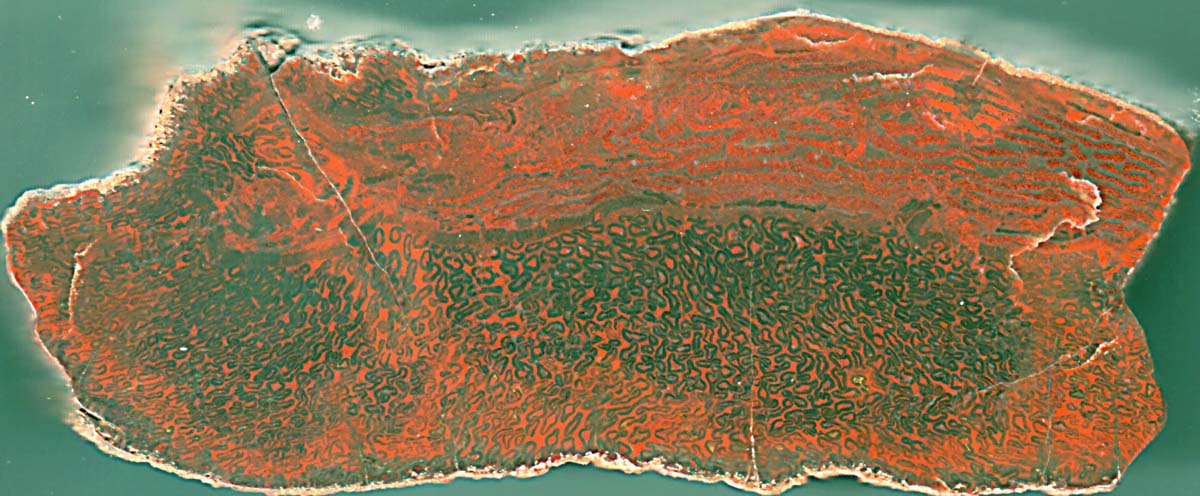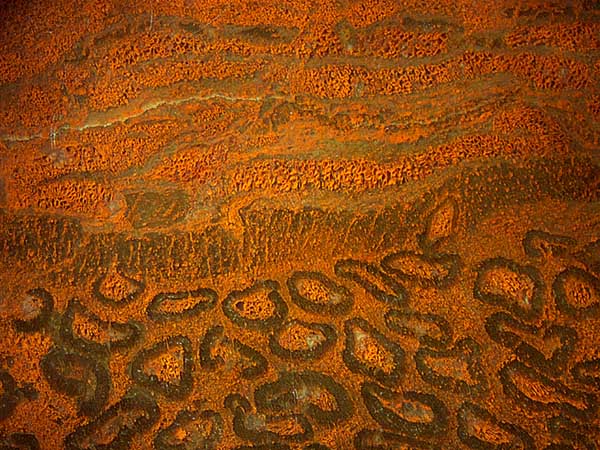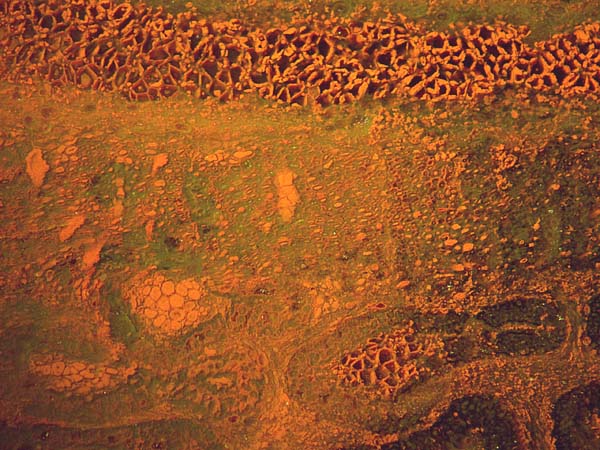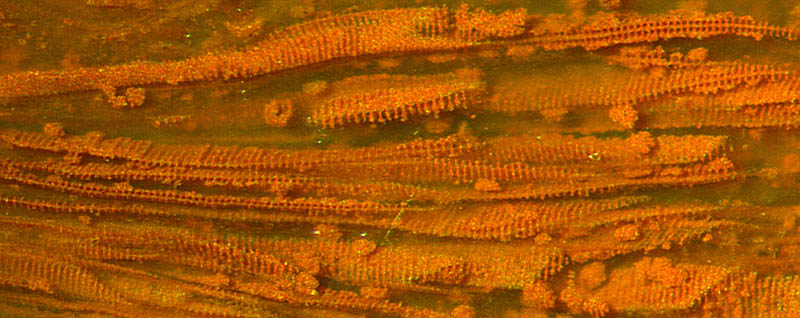Deep-red Psaronius from the
Doehlen basin
Fossil trunks of Palaeozoic tree ferns, known
under the collective term
Psaronius, are much
less abundant than the usual petrified wood but make beautiful sights
in exhibitions. Big and
beautiful specimens are known from Chemnitz.
Less conspicuous but nevertheless interesting are the rare finds from
the Doehlen basin:
Permian
Chert News 6,
9,
12,
25.
There, small well-preserved fern pinnules and frond parts had been
found and described as "maggot fern" Scolecopteris elegans
[1], and many more of them have been found recently. Careless handling
of the "maggot stone" problem caused the repeatedly published error
that the fossil "maggot ferns" from
the Doehlen basin represented only this one species [2,3].
Thorough
inspection has recently revealed that they represent
more than one tree fern species [4,5,6].
This poses the problem of how to relate the foliage to the trunks,
which is not considered here.

Fig.1: Cross-section
of a slightly flattened Psaronius
tree
trunk
fragment with
differing aspects
of the central part (above) and surrounding aerial root mantle.
Image width 13cm.
Note that the peculiar
way of Psaronius
growth implies that there is nearly all
aerial roots at the
base but
no such near the top. Hence, the present
sample must be a stem fragment from somewhere in between.
(For a
concise description of Psaronius
growth
see [7].)
This
sample does not
represent a novel red Psaronius but a colour variety
of the fossil, resulting from profuse
precipitation of hematite during or after silicification. The
inhomogeneus distribution of the red stain, mainly in a broad strip
along the edge and beside some crack, indicates diffusion in the solid
state. The latter follows also from the
vanished red stain close to the crack with red
surroundings above right. Obviously this crack had favoured the red
staining of nearby conducting strands but later enabled the stain to
get partially removed. In this sample the aerial
roots are (partially)
separated from the
central part of the
stem with its conducting strands by a "palisade wall" of sclerenchyma
as in Fig.2. Two
aerial roots seem to have just squeezed through. The wall structure
can be so vague that it is hardly seen, as in Fig.3. It is seen in a
few publications, e.g. [8].
Enigmatic
is the
similarity of the "palisade walls" in Fig.2 and in an
unidentified
stem with a wood ring
outside [9].

Fig.2:
Wall
separating the
central part with conducting strands and the aerial root mantle; detail
of the Psaronius
cross-section
in Fig.1. Image width 17.5mm.
Fig.3 (below): Three aspects of tracheid
cross-sections in one picture: forming
a ribbon-like conducting
strand (above), forming a strand inside an adventitious root
(below right) with "empty"
tracheids, same as before but tracheids with
opaque fill (left). Image
width 5.5mm.
The tracheids are thin-walled but may appear thick-walled due to
mineral deposits,
as seen on the ribbon-like
conducting
strand cross-section in Fig.3. A few
thin-walled
ones are seen on the left. The
glass-clear fill makes the tracheid sections appear
deep dark inside, which also applies to the conducting strand of the
aerial root below
right in the image.
The distribution of tracheids
with opaque fills suggests that
the
originally clear chalcedony turned opaque under the influence of
diffusion from outside and from cracks.

Fig.4: Longitudinal
section of a bunch of slightly bent tracheids
with scalariform wall. Image
width 1.2mm.
The clear chalcedony inside the tracheids offers
a surprisingly
detailed view of the tracheid walls in Fig.4. The apparent problems
related to the aspect
of the tracheid walls have been discussed
in Permian
Chert News 25
.
The images show details from two polished cut faces of the sample W/20, found about 1990 by S. Weiss in a patch of glacial gravel on the Wilmsdorf golf course near Freital (Doehlen Basin).
H.-J.
Weiss 2022
[1]
E.
Zenker:
Scolecopteris elegans,
ein neues fossiles Farrngewächs mit
Fructification. Linnaea 11(1837), 509-12.
[2] M. Barthel:
Die Madensteine vom Windberg. in: U. Dernbach, W.D. Tidwell:
Geheimnisse versteinerter Pflanzen. D'ORO 2002. S.65-77.
[3] M. Barthel: Die
Rotliegendflora der Döhlen-Formation. Geologica Saxonica 61 (2) 2015
(2016 erschienen), 105-238. S.226
[4] H.-J.
Weiss:
Scolecopteris
synangium stalks
– real and illusory.
www.chertnews.de, Permian Chert News 4.
[5] H.-J.
Weiss: Maggot
fern disputes. www.chertnews.de,
Permian Chert News 24.
[6] H.-J.
Weiss: Maggot
fern confusion. www.chertnews.de,
Permian Chert News 26.
[7] H. Steur:
https://steurh.home.xs4all.nl/epsaron
The tree fern Psaronius
[8] B. M.
Stidd:
Morphology and anatomy of
the frond of Psaronius. Palaeontographica
B 134 (1971), 87-123, Plate 16 Fig.8.
[9] H.-J.
Weiss:
A
small seed
fern stem...
www.chertnews.de, Fossil Wood News 19.
 |
 39 39 |






 39
39